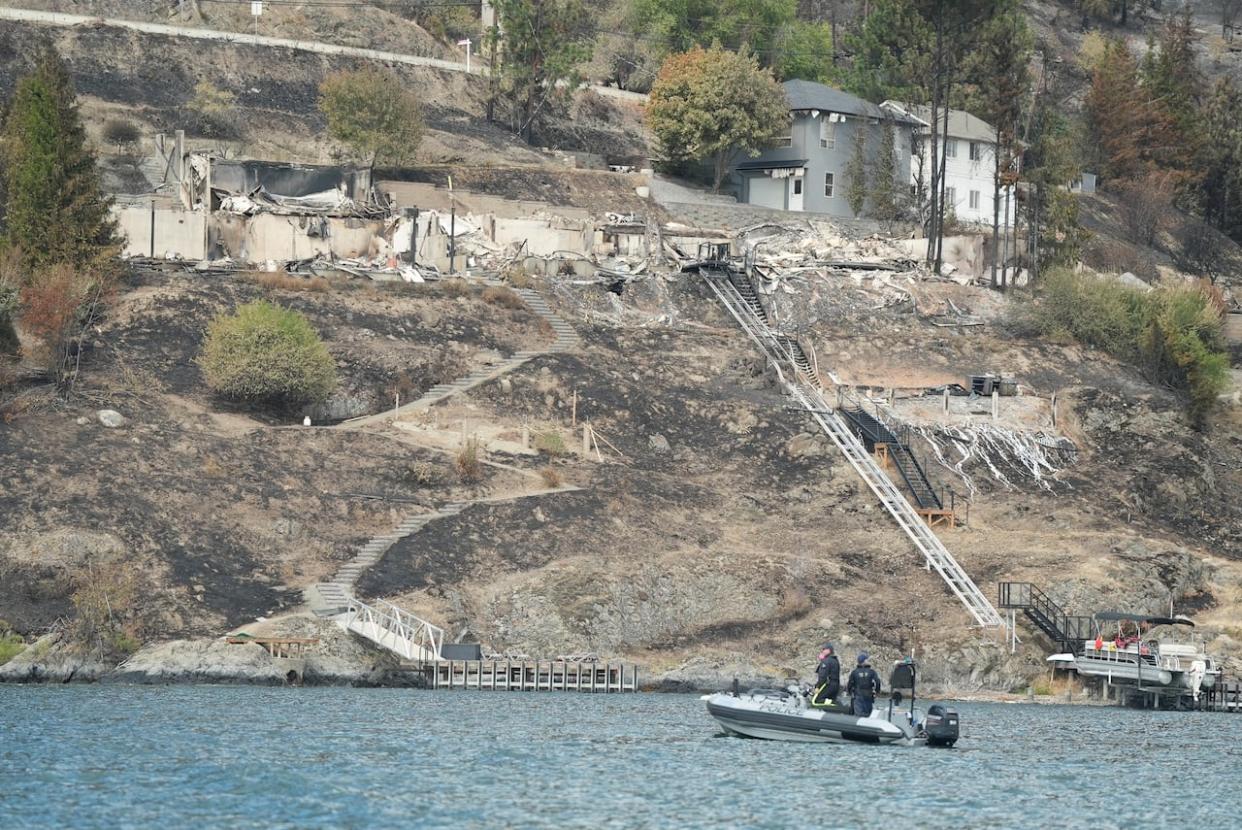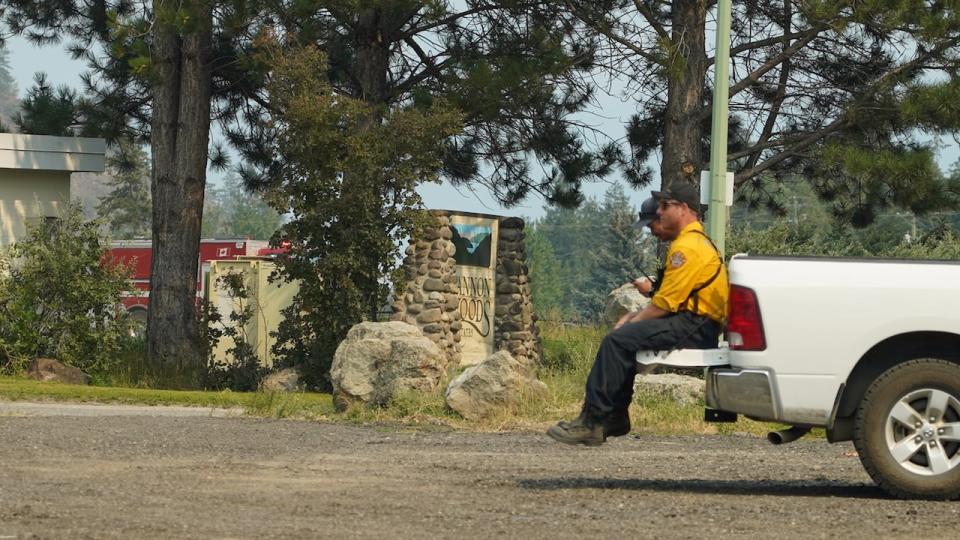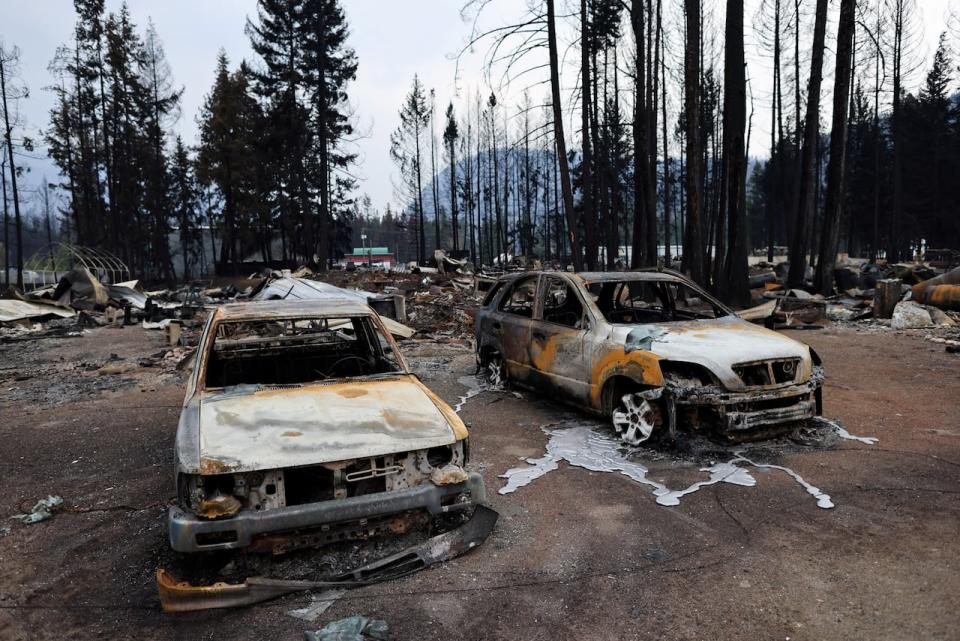Number of homes destroyed or damaged by wildfire in B.C.'s Okanagan raised to 189

The latest on the wildfires:
The Central Okanagan Emergency Operation Centre says new assessments have revealed 189 structures were burned by the McDougall Creek wildfire, up from 181.
Officials in B.C.'s Shuswap begin Monday notifying residents about properties affected by wildfire there.
People in B.C.'s northwest are once again watching fires closely as the the Village of Witset issued an evacuation alert.
The B.C. Wildfire Service says from April 1, it's spent an estimated $585 million on fire suppression efforts.
Kelowna-area officials have updated the number of structures that were damaged or destroyed by the McDougall Creek wildfire over the past 11 days from 181 to 189.
The new number comes after crews were better able to assess fire-damaged areas in and around West Kelowna, B.C.
"Our hearts go out to all who have been impacted by this unprecedented fire event, and particularly to those whose homes have been significantly damaged or lost," said Sally Ginter, Central Okanagan Emergency Operations Centre director in a release and as part of the ninth and final press conference after the fire was discovered on Aug. 15.
Officials are asking property owners in the West Kelowna Estates, and those with access from Bear Creek Main and neigbourhoods along Westside Road to once again check a web portal for status updates on properties.
The McDougall Creek fire continues to burn out of control over 123 square kilometres, but fire suppression efforts have pushed it back into the hills above West Kelowna, which is located on the opposite shore of Okanagan Lake from Kelowna, B.C.
The B.C. Wildfire Service posted over the weekend an eight-minute video chronicling the response to the wildfire after a cold front caused its explosive growth on Aug. 17.
The West Kelowna Fire Department is returning to "normal day-to-day operations" as the number of residents under evacuation order continues to steadily decline.
As of Monday, 2,381 properties were under evacuation order in the Regional District of the Central Okanagan, a reduction of more than 300 from the day before.
Officials at the Monday news conference said it will still be a long road to recovery, with an undetermined amount of time still needed before some residents who have suffered losses will be able to be safely escorted into burned areas to visit their properties.
"A tough week is just beginning for many," said West Kelowna Fire Chief Jason Brolund.

B.C. Wildfire Service firefighters in West Kelowna's Shannon Lake neighbourhood on Aug. 24. (Tom Popyk/CBC)
He said included in the lifting of evacuation orders was one for Rose Valley Elementary School in West Kelowna, where he said teachers have gone back in to start setting up for classes.
"That's a major milestone for the community," said Brolund.
Shuswap damage
Meanwhile, residents of the Shuswap region to the north are due to learn about the condition of their properties affected by a devastating wildfire in the area.
Derek Sutherland, director of the emergency operations centre for the Columbia Shuswap Regional District, said staff will call residents to talk about next steps starting Monday.
The estimated number of properties destroyed by the Bush Creek East wildfire is unchanged at 131, he said, with another 37 sustaining damage.
The district is planning to open a resiliency centre in Salmon Arm, B.C. — around 70 kilometres east of Kamloops — to support displaced residents "now and well into the future,'' Sutherland said at a Sunday afternoon briefing.
B.C. Hydro personnel are working to replace toppled poles, he said, but it will be several more days before it becomes clear when power might be restored for many in the area affected by the 430-square-kilometre blaze.
When asked what parents and students can expect for the return to classes this fall, Sutherland said officials are discussing plans with the local school district.
Mike McCulley, an information officer with the B.C. Wildfire Service, told the briefing Sunday that crews are focusing efforts on the perimeter of the fire west of Sorrento — around 20 kilometres north of Salmon Arm — as well as in the Lee Creek and Magna Bay areas on the north side of Shuswap Lake and around Adams Lake further northwest.
While Monday is set to bring temperatures nearing 30 C, cooler weather is expected Tuesday along with some rain, which would be "great news,'' McCulley said.

Burned vehicles are pictured Aug. 23 after the Bush Creek East wildfire destroyed dozens of homes in several rural communities including Scotch Creek, Lee Creek and Celista in the Shuswap region of B.C. (Jesse Winter/Reuters)
The regional district is working with residents who are interested in responding to wildfires to provide them with safety training, Sutherland added.
Anyone who has signed up to work with the B.C. Wildfire Service is being provided with food, gas and water, McCulley said.
As of Monday morning there are 376 active blazes in British Columbia, including 12 designated "wildfires of note," meaning they're highly visible or pose a threat to public safety. The two wildfires that had threatened the District of Lake Country and the City of Kelowna are classified as "being held" and crews are patrolling for hotspots.
On Monday, the B.C. Wildfire Service said that from April 1, it's spent an estimated $585 million on fire suppression efforts across the province.
Northwest fire threat
After a few weeks of reprieve, residents in B.C.'s northwest are once again watching fires closely. The Village of Witset, about 170 kilometres northeast of Terrace, issued an evacuation alert Sunday due to the John Brown Creek wildfire.
The fire has been burning out of control since it was discovered on July 10. It's currently 3.5 square kilometres in size and just four kilometres from Witset, where around 1,700 people live.
"It was putting up some smoke over the last month or so, but fire activity was relatively quiet. That's changed," said Michelle Larstone with the B.C. Wildfire Service.
High temperatures, above 30 C in some areas, and ongoing drought has exacerbated wildfire risk in the region, according to officials.
Larstone said there is a chance of rain in the area for Tuesday.
In the far northwest, another evacuation order was issued this weekend due to the Little Blue River wildfire, which covers parts of Highway 37, south of the Yukon border.
The highway is now closed in both directions from the Beaver Dam Pullout to the junction with the Alaska Highway.
Smoky air
Air quality advisories stemming from wildfire smoke remain in effect for B.C.'s South Coast and southern Interior, along with parts of the north from the Bulkley Valley to the Peace region.
Environment Canada has also issued a heat warning for inland sections of the North Coast, including Terrace and Kitimat, as well as the Peace region.
Daytime highs near 30 C are expected to persist until Tuesday near the coast and Wednesday in northeastern B.C., the weather office said.
READ MORE:
Anyone placed under an evacuation order should leave the area immediately.
Evacuation centres have been set up throughout the province to assist anyone evacuating from a community under threat from a wildfire.
To find the centre closest to you, visit the EmergencyInfoBC website.
Evacuees are encouraged to register with Emergency Support Services online, whether or not they access services at an evacuation centre.
Do you have a story to share?
If you've been affected by the B.C. wildfires and want to share your story, email cbcnewsvancouver@cbc.ca.


